BUICK RIVIERA 1993 Owner's Guide
Manufacturer: BUICK, Model Year: 1993, Model line: RIVIERA, Model: BUICK RIVIERA 1993Pages: 324, PDF Size: 16.01 MB
Page 31 of 324
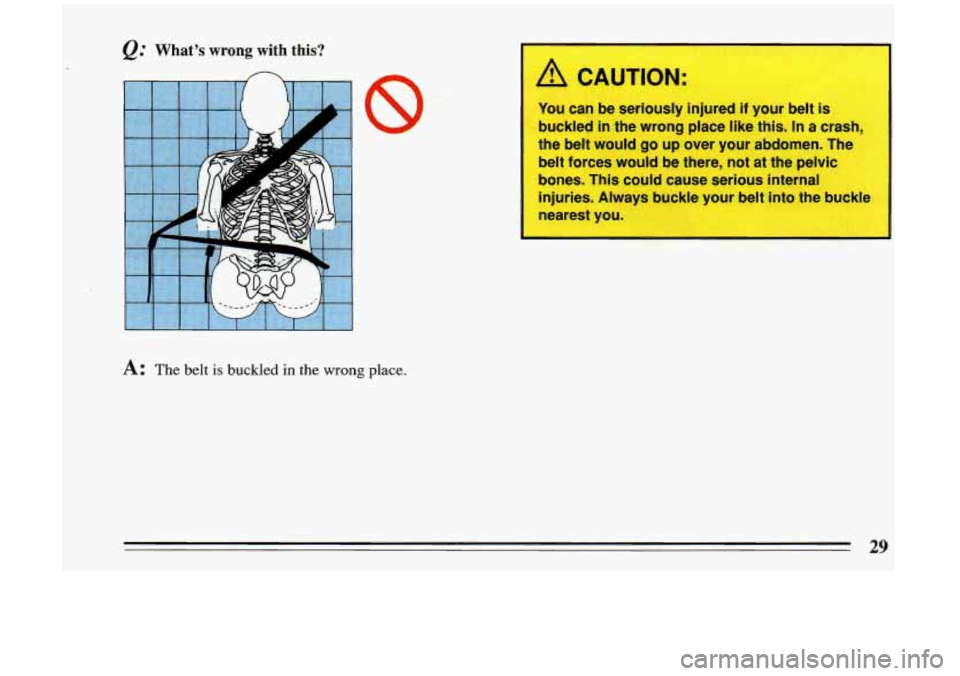
@ What’s wrong with this?
n
I
A: The belt is buckled in the wrong place.
A CAUTION:
You can be seriously injured if your belt is
buckled
in the wrong place like this. In a crash,
the belt would
go up over your abdomen. The
belt forces would be there, not at the pelvic
bones. This could cause serious internal
injuries. Always buckle your belt into the buckle
nearest you.
x<->. -j;w;.!’.C , hii’. &hbLe:J*&A&
I
29
Page 32 of 324
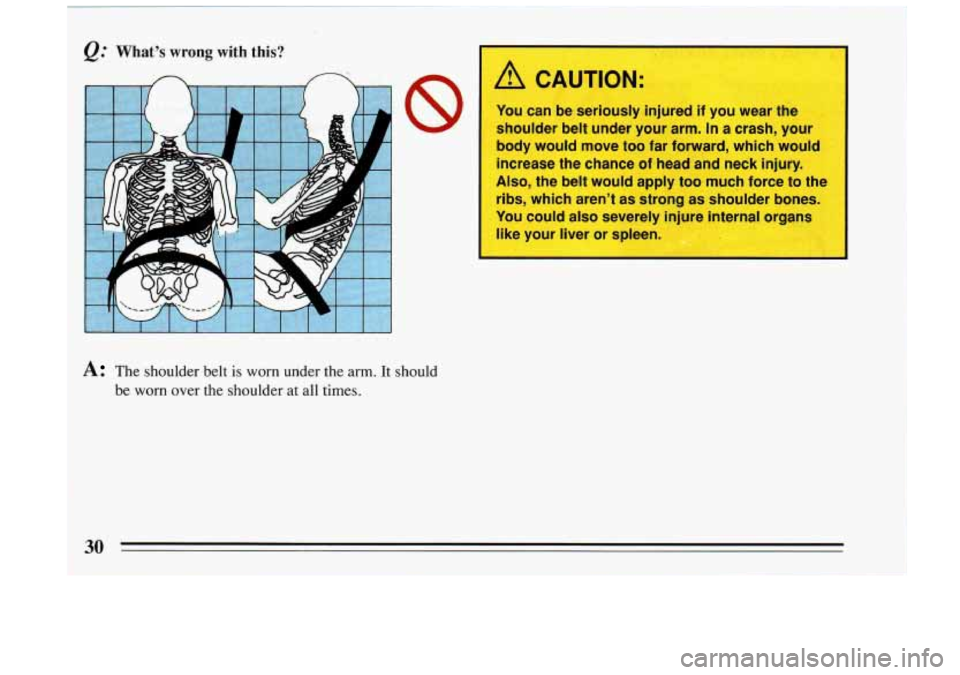
@ What’s wrong with this? I
* The shoulder belt is worn under the arm. It should
be worn over the shoulder
at all times.
A CAUTION:
You can be seriously injured if you wear the
shoulder belt under your arm.
In a crash, your
body would move too far forward, which would
increase the chance of head and neck injury.
Also, the belt would apply too much force to the
ribs, which aren’t as strong as shoulder bones.
You could also severely injure internal organs
like your liver or spleen.
I
I
Page 33 of 324
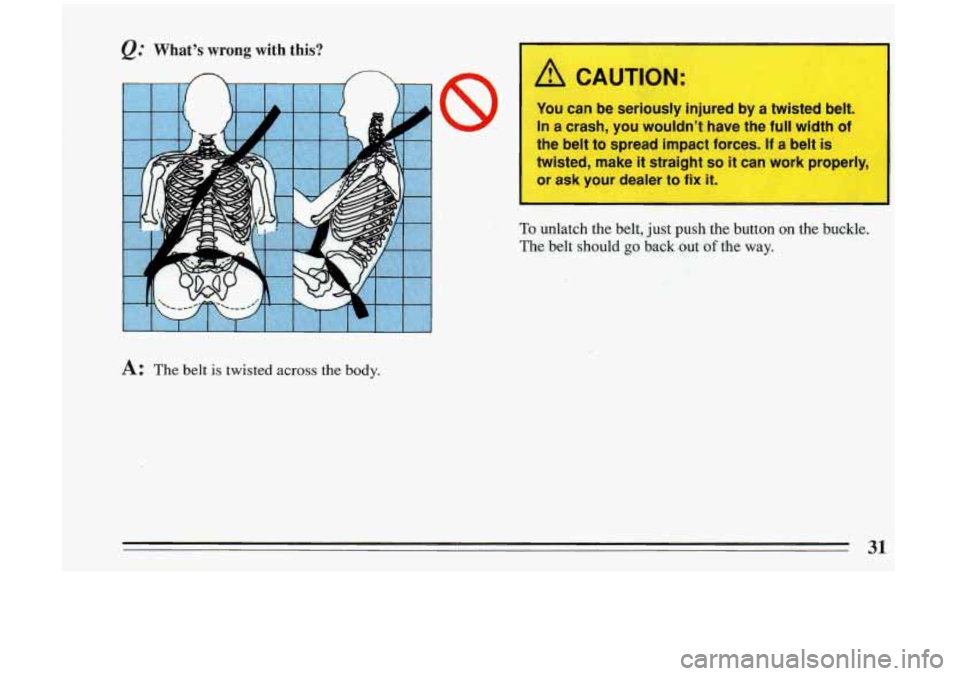
@ What’s wrong with this?
I
/A CAUTION:
You can be seriously injured by a twisted belt.
In
a crash, you wouldn’t have the full width of
the belt to spread impact forces.
If a belt is
twisted, make it straight
so it can work properly,
or ask your dealer
to fix it.
A: The belt is twisted across the body.
Page 34 of 324
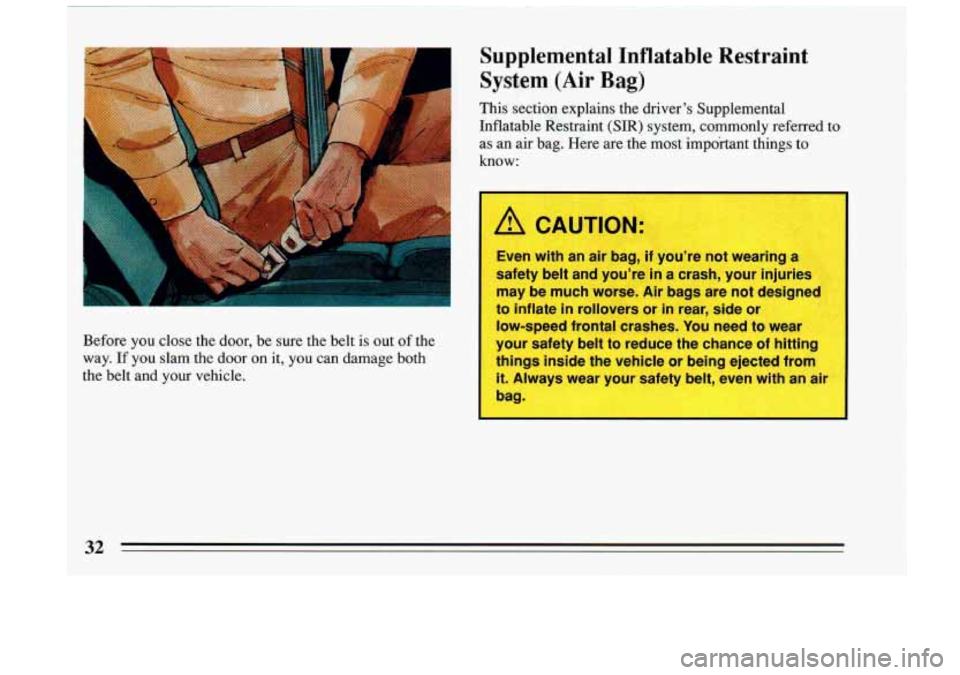
Before you close the door, be sure the belt is out of the
way.
If you slam the door on it, you can damage both
the belt and your vehicle.
Supplemental Inflatable Restraint
System
(Air Bag)
This section explains the driver’s Supplemental
Inflatable Restraint (SIR) system, commonly referred to
as an air bag. Here are
the most impdi-tant things to
know:
A CAUTION:
Even with an air bag, if you’re not wearing a
safety belt and you’re
in a crash, your injuries
may be much worse. Air bags are not designed
I
to inflate in rollovers or in rear, side or
low-speed frontal crashes. You need to wear
your safety belt to reduce the chance of hitting
things inside the vehicle or being ejected from
it. Always wear your safety belt, even with an air
bag.
Page 35 of 324
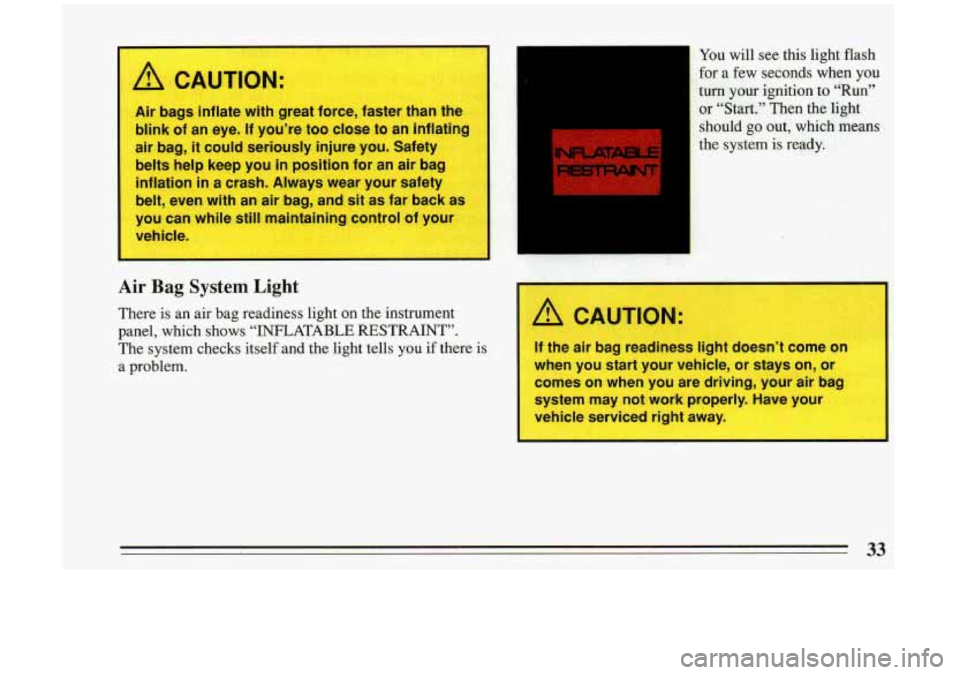
I A CAUTION:
Air bags :..Hate with great force, faster than the
blink of an eye. If you’re too close to an inflating
air bag, it could seriously injure you. Safety
belts help keep you
in position for an air bag
inflation
in a crash. Always wear your safety
belt, even with an air bag, and sit as far back as
you can while
still maintaining control of your
vehicle.
-
Air Bag System Light
There is an air bag readiness light on the instrument
panel, which shows “INFLATABLE RESTRAINT”. You
will see this light flash
for
a few seconds when you
The system checks itself and. $helight
?: tells you if there is
a problem. turn your ignition
to “Run”
or
“Start.” Then the light
should go out, which means
the system
is ready.
A CAUTION:
If the air bag readiness light doesn’t come on
when you start your vehicle, or stays on, or
comes on when you are driving, your air bag
system may not work properly. Have your
vehicle serviced right away.
33
Page 36 of 324
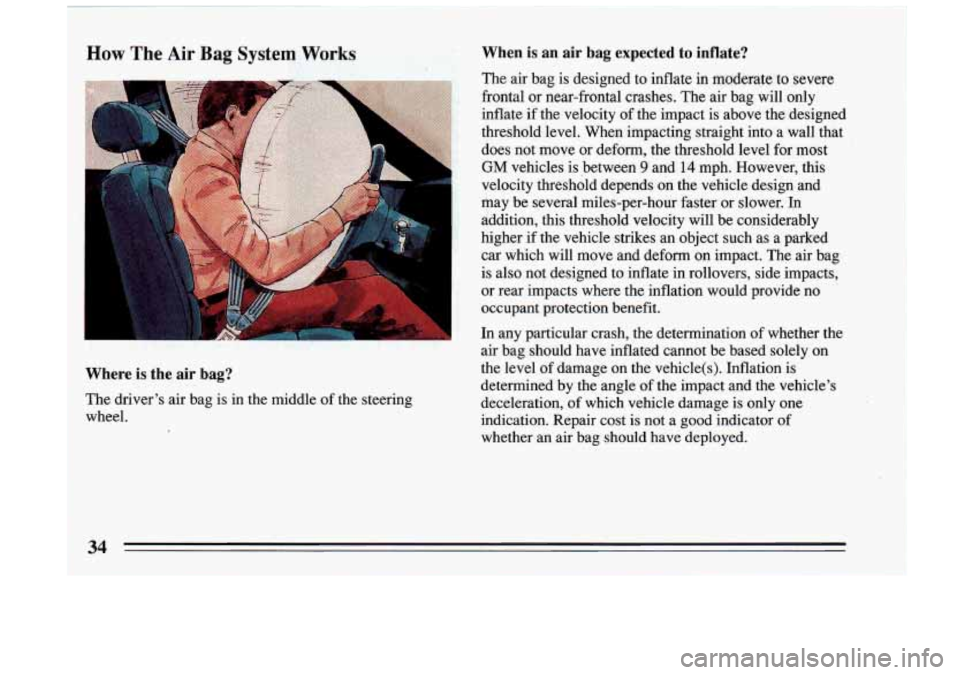
Where is the air bag?
When is an air bag expected to inflate?
The air bag is designed to inflate in moderate to severe
frontal or near-frontal crashes. The air bag
will only
inflate
if the velocity of the impact is above the designed
threshold level. When impacting straight into a wall that
does not move or deform, the threshold level for most
GM vehicles is between 9 and 14 mph. However, this
velocity threshold depends on the vehicle design and
may be several miles-per-hour faster or slower. In
addition, this threshold velocity will be considerably
higher
if the vehicle strikes an object such as a parked
car which will move and deform
on impact. The air bag
is also not designed to inflate in rollovers, side impacts,
or rear impacts where the inflation would provide no
occupant protection benefit.
In any particular crash, the determination of whether the
air bag should have inflated cannot be based solely on
the level of damage on the vehicle(s). Inflation is
determined
by the angle of the impact and the vehicle’s
deceleration, of which vehicle damage is only one
indication. Repair cost is not a good indicator of
whether an air bag should have deployed.
Page 37 of 324
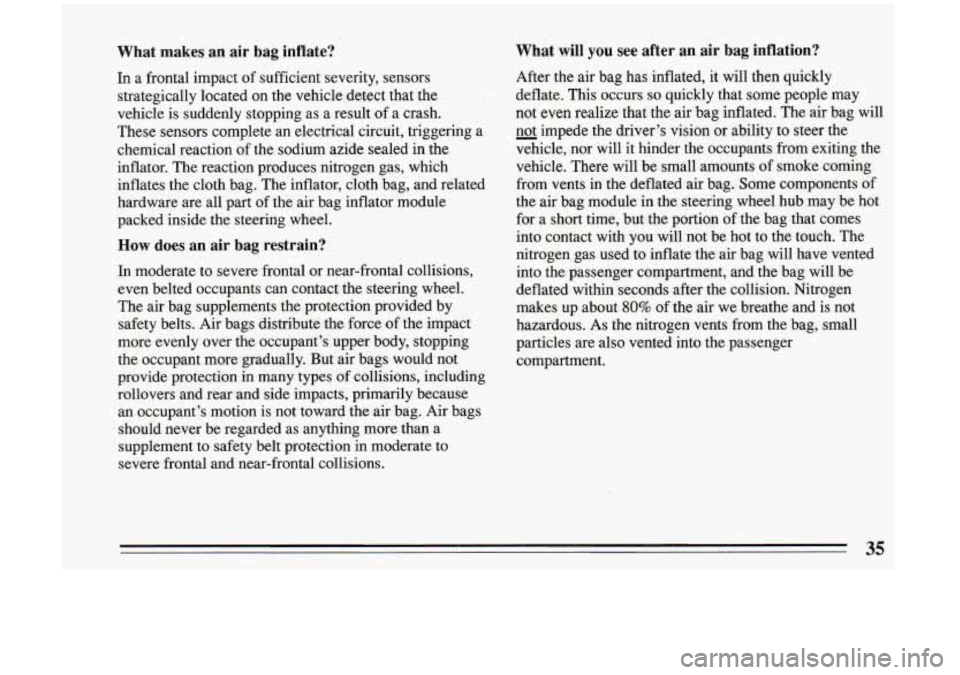
What makes an air bag inflate?
35
Page 38 of 324
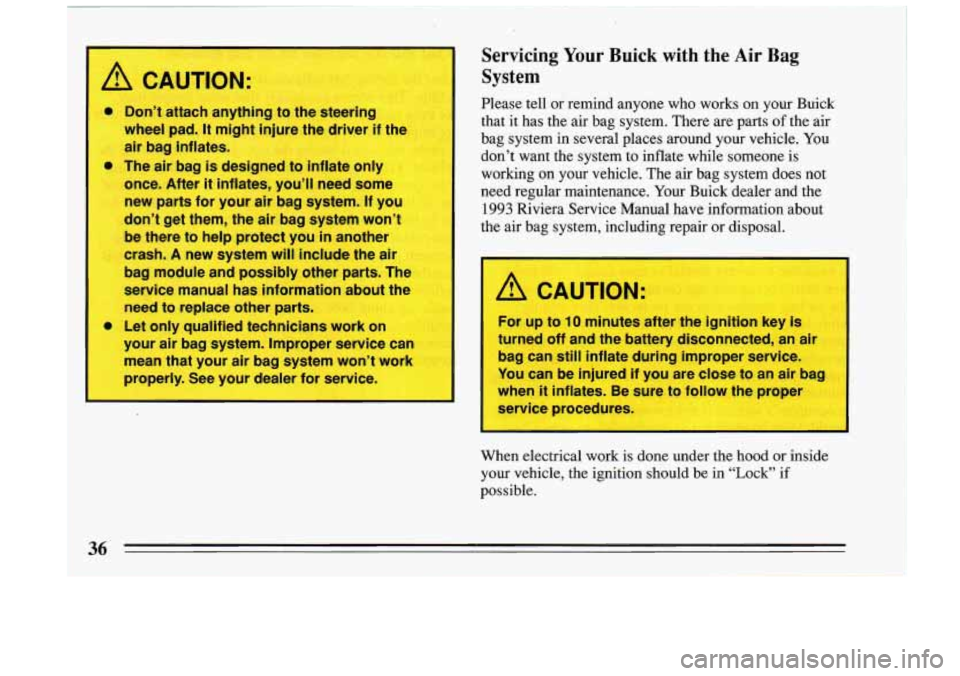
-T
A C UTION:
A
0 Don’t attach anything to the steer J
wheel pad. It mi -It injure the driver if 1
air bag inflates.
The air bag is designed to inflate only
once. After
it inflates, you’ll need some
new parts for your air bag system.
If you
don’t get them, the air bag system won’t
be there to help protect you
in another
crash.
A new system will include the air
bag module and possibly other parts. The
service manual has information about the
need to replace other parts.
Let only qualified technicians work on
your air bag system. Improper service can
mean that your air bag system won’t work
properly. See your dealer for service.
Servicing Your Buick with the Air Bag
System
Please tell or remind anyone who works on your Buick
that it has the air bag system. There are parts
of the air
bag system in several places around your vehicle. You
don’t want the system to inflate while someone is
working on your vehicle. The air bag system does not
need regular maintenance. Your Buick dealer and the
1993 Riviera Service Manual have information about
the air bag system, including repair or disposal.
A CAUTION:
For up to 10 minutes a1 r the ignition key is
turned off and the battery disconnected, an air
bag can still inflate during improper service.
You can be injured
if you are close to an air bag
when
it inflates. Be sure to follow the proper
I service procedures.
When electrical work is done under the hood or inside
your vehicle, the ignition should be in “Lock” if
possible.
Page 39 of 324
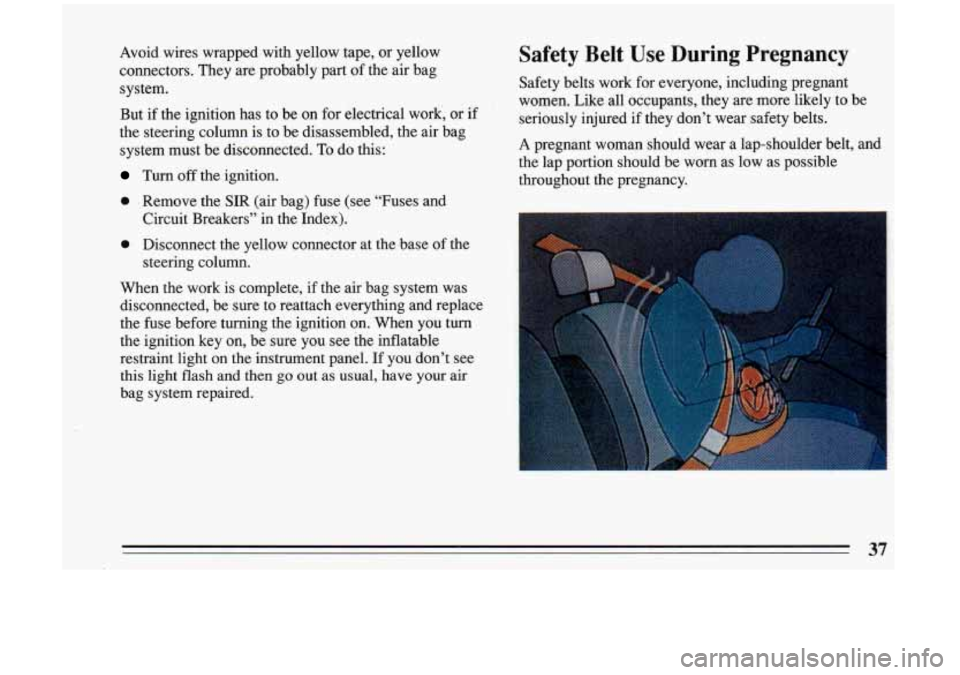
Avoid wires wrapped with yellow tape, or yellow
connectors. They are probably part of the air bag
system.
But if the ignition has to be on for electrical work, or if
the steering column is to be disassembled, the air bag
system must be disconnected.
To do this:
Turn off the ignition.
0 ‘Remove the SIR (air bag) fuse (see “Fuses and
Circuit Breakers” in the Index).
Safety Belt Use During Pregnancy
Safety belts work for everyone, including pregnant t
women. Like all occupants, they are more likely to be
seriously injured if they don’t wear safety belts.
A pregnant woman should wear
a lap-shoulder belt, and ’
the lap portion should be wok as low as possible
throughout the pregnancy.
0 Disconnect the yellow connector at the&ase of the
When the work is complete, if the air bag system was
disconnected, be sure to reattach everything and replace
the fuse before turning the ignition
on. When you turn
the ignition key on, be sure you see the inflatable
restraint light on the instrument panel.
If you don’t see
this light flash and then
go out as usual, have your air
bag system repaired. steering column.
37
Page 40 of 324
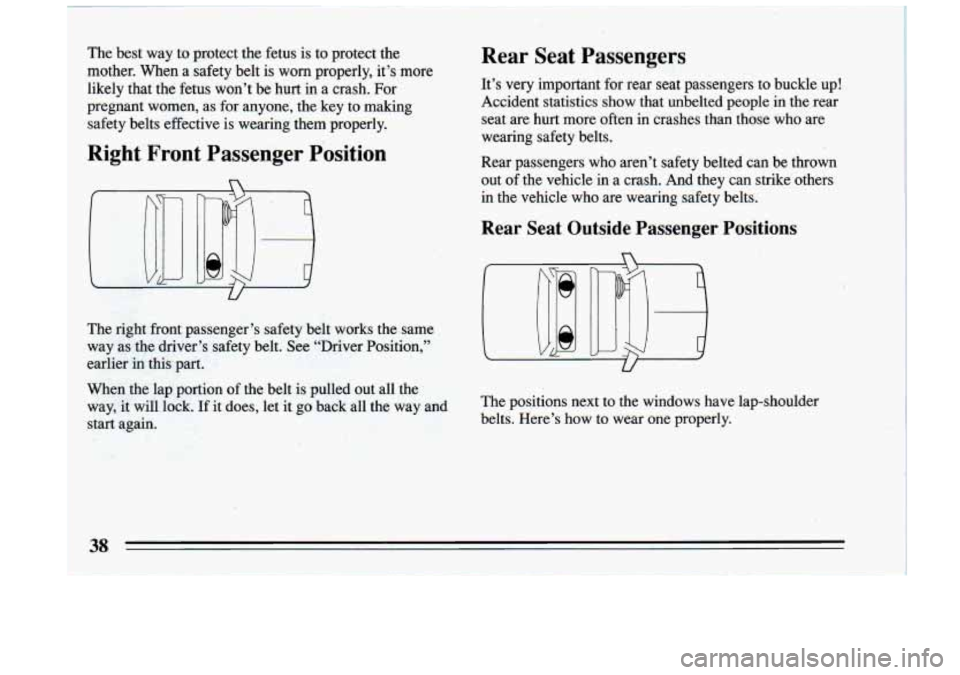
The best way to protect the fetus is to protect the
mother. When a safety belt is worn properly, it’s
more
likely that the fetus won’t be hurt in a crash. For
pregnant women, as for anyone, the key to making
safety belts effective is wearing them properly.
Right Front Passenger Position
The rightfront passenger’s safety belt works the same
vvay as. the driver’s safety belt. See “Driver Position,”
earlier
h. this part.
%When.the lap portion of the belt is pulled out all the
way, it
will lock. If it does, let it go back all the way and
tart again.
Rear Seat Passengers
It’s very important for rear seat passengers to buckle up!
Accident statistics show that unbelted people
in the rear
seat are hurt more often in crashes than those who
are
wearing safety belts.
Rear passengers who aren’t safety belted can be thrown out
of the vehicle in a crash. And they can strike others
in the vehicle who are wearing safety belts.
Rear Seat Outside Passenger Positions
U
The positions next to the windows have lap-shoulder
belts. Here’s how to wear one properly.